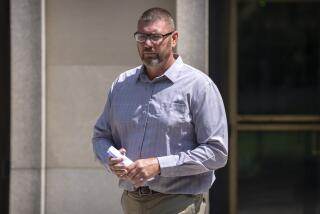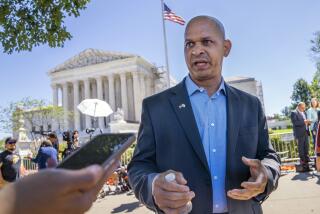Faulty intelligence blamed for disastrous response to Capitol riots

- Share via
WASHINGTON — Former security officials told Congress on Tuesday that faulty intelligence was to blame for failing to properly prepare for last month’s bloody insurrection at the U.S. Capitol, testifying in dramatic detail about their shock at confronting a violent insurrection and not the manageable protest they had been expecting.
“The events I witnessed on Jan. 6 was the worst attack on law enforcement and our democracy that I’ve seen in my entire career,” former Capitol Police Chief Steven Sund, who resigned in the days after the attack, testified before a joint hearing of the Senate Homeland Security and Rules committees.
“None of the intelligence we received predicted what actually occurred,” he said. “We properly planned for mass demonstrations, with possible violence. What we got was a military-style coordinated assault on my officers and a violent takeover of the Capitol.”
Sund was joined by two former Capitol security officials, as well as acting Washington, D.C., Police Chief Robert Contee III, at the hearing, the first to examine the Jan. 6 insurrection by a marauding pro-President Trump mob that left five people, including a police officer, dead. The hearing came just 10 days after the Senate voted to acquit the former president at his second impeachment trial on allegations he incited his supporters to storm Congress to stop it from counting electoral college votes that would cement Joe Biden’s victory.
All four security officials testified that federal law enforcement and intelligence agencies did not provide them with specific warnings that the Capitol might come under attack. They had planned, they testified, to confront a peaceful protest similar to the mostly peaceful ones by die-hard Trump supporters upset about the results of the November election.
Lawmakers have expressed dismay that Capitol police and federal agencies were caught so off guard, especially because media reports had indicated Trump supporters might try to prevent Congress from counting the electoral votes. Senators said they would continue holding such hearings, including one next week featuring testimony from federal law enforcement and military officials.
“We are here today to better understand what was known in advance, what steps were taken to secure the Capitol and what occurred that day, because we want to ensure nothing like this happens again,” said Sen. Amy Klobuchar (D-Minn.), chairwoman of the Rules Committee.
In addition to several congressional inquiries, the Justice Department has launched a wide-ranging investigation into the assault and has charged more than 250 people on allegations they stormed the building, destroyed property and threatened the lives of those there, including lawmakers, staffers, the public, reporters and police. The Justice Department has said that more than 130 law enforcement officers were injured in the insurrection.
While Sund and Contee have spoken publicly about the attack, Tuesday was the first time the public has heard from two key Capitol security officials: former Senate Sergeant at Arms Michael Stenger and former House Sergeant at Arms Paul Irving, who served as Sund’s bosses and resigned in the wake of the attack. They testified they had no indication there would be an insurrection.
“The intelligence was not that there would be a coordinated assault on the Capitol, nor was that contemplated in any of the interagency discussions that I attended in the days before the attack,” Irving testified.
Sen. Gary Peters (D-Mich.), chairman of the Senate Homeland Security Committee, quizzed Sund about intelligence reports generated by the FBI and his own department that indicated potential danger. Sund testified that his agency on Jan. 5 received a report from the FBI’s Norfolk, Va., office warning that Trump supporters were calling for violence. But the Capitol police officer who received the warning didn’t share it with him or commanders. Sund said he saw it for the first time on Monday.
Even if they had read it before Jan. 6, Sund said, it’s unclear whether the warning would have changed his agency’s security posture. “It would have been helpful to have been aware of,” he said, though “it is strictly raw data, it’s raw intelligence.”
Contee testified that the FBI report came in a run-of-the-mill email and was not flagged as a high-priority alert.
“I would think that something of that nature would rise to the level of more than just an email,” he said.
Lawmakers spent considerable time questioning the security officials about delays in getting help from the National Guard. Contee testified that he was on a phone call with Army leaders during the insurrection and was frustrated that they didn’t sense the urgency.
He listened as Sund pleaded with the Army brass to send troops and concluded military officials seemed to be going through a “check the boxes” exercise while expressing concerns it might look bad to have troops on the Capitol grounds.
“I was just stunned because I have officers out there fighting for their lives,” Contee said.
Three hours after the Capitol police chief pleaded with the Army brass to send the National Guard, the first batch of such soldiers mustered on the Capitol grounds, Sund testified.
The hearing started off dramatically when Capitol Police Capt. Carneysha C. Mendoza testified about engaging in four hours of hand-to-hand fighting with rioters in the Capitol. Insurrectionists nearly broke her arm, and she also suffered chemical burns to her face from tear gas deployed by the insurrectionists. Those burns have not fully healed, she testified.
Mendoza said she spent the day after the attack at a hospital, comforting the family of Officer Brian Sicknick as he died from injuries sustained in the assault.
“We could have had 10 times the amount of people working with us, and I still believe the battle would have been just as devastating,” Mendoza testified. “As an American and Army veteran, it’s sad to see us attacked by our fellow citizens. I’m sad to see the unnecessary loss of life.”
More to Read
Get the L.A. Times Politics newsletter
Deeply reported insights into legislation, politics and policy from Sacramento, Washington and beyond. In your inbox twice per week.
You may occasionally receive promotional content from the Los Angeles Times.










